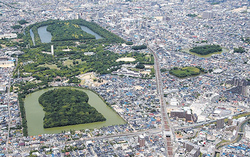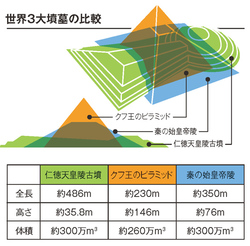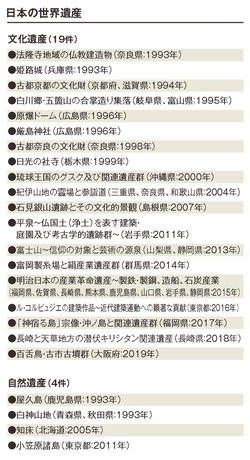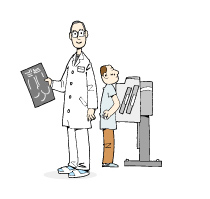百舌鳥・古市古墳群が世界文化遺産に登録【国際】

Mozu-Furuichi Kofun Group Now On UNESCO World Heritage list
【日本の世界遺産は文化遺産、自然遺産合わせて23件に】
アゼルバイジャンで開催されたユネスコ(国連教育科学文化機関)の世界遺産委員会は7月6日、日本が推薦していた「百舌鳥(もず)・古市古墳群」を世界文化遺産に登録することを決めました。日本の世界文化遺産の登録は7年連続で19件、自然遺産4件を含めると計23件目となります。大阪府の遺産が世界遺産に登録されるのは初めてです。
【Japan now has 23 World Heritage Sites, including cultural and natural heritage sites】
The World Heritage Committee of UNESCO (United Nations Educational, Scientific and Cultural Organization), held in Azerbaijan, decided on July 6 to register " Mozu-Furuichi Kofun Group " that Japan had recommended as a World Cultural Heritage site. With the registration, the number of world heritage sites in Japan increased to 23 includind 19 cultural and four natural sites. It is the first World Heritage site in Osaka Prefecture.
 - 人類全体の遺産の保護・保存をめざして -
- 人類全体の遺産の保護・保存をめざして -ユネスコの1972年の総会で、「世界の文化遺産及び自然遺産の保護に関する条約(世界遺産条約)」が採択されました。世界遺産条約は、人類全体に顕著な普遍的価値をもたらす文化遺産や自然遺産を破壊や損傷から保護し、後世まで末永く守り伝えるために、国際的な協力及び援助体制の確立を目的にしています。
世界遺産には、建築物や遺跡などの文化遺産と、動植物の自生地や自然景観などの自然遺産、これら両方を兼ね備える複合遺産があります。2018年7月現在、世界遺産に登録されているのは1,092件(文化遺産845件、自然遺産209件、複合遺産38件)で、このうち日本からは22件(文化遺産18件、自然遺産4件)が登録されています。
- Protecting and preserving the heritage of the entire human race -
The Convention concerning the Protection of World Cultural and Natural Heritage (World Heritage Convention) was adopted by the General Conference of UNESCO in 1972. The purpose of the World Heritage Convention is to establish an effective system of collective protection of the cultural and natural heritage of outstanding universal value for all mankind from destruction and damage, and to pass them on to future generations.
The World Heritage sites include cultural heritage sites such as buildings and ruins, natural heritage such as habitats of plants and animals, and mixed heritage sites that combine both elements of culture and nature. As of July 2018, there are a total of 1,092 World Heritage Sites (845 cultural, 209 natural, and 38 mixed properties). Japan has 22 World Heritage sites, including 18 cultural and four natural sites.
 - 構成資産は大仙古墳(仁徳天皇陵)など49基 -
- 構成資産は大仙古墳(仁徳天皇陵)など49基 -日本で23件目の世界遺産となった百舌鳥・古市古墳群は、古墳時代の最盛期(4世紀後半~5世紀後半)に、当時の政治や文化の中心地だった大阪府南部地域に築かれました。構成資産となった49基の古墳は、大阪府堺市の百舌鳥地域に23基、羽曳野市と藤井寺市にまたがる古市地域には26基あり、それぞれ4キロ四方の地域に点在しています。
百舌鳥地域の仁徳天皇陵とされる大仙古墳は、墳墓としては世界最大級の全長486mを誇り、エジプトのクフ王のピラミッドより高さで劣るものの、長さでは2倍以上となっています。古市地域にある誉田御廟山古墳(応神天皇陵)の全長は国内で2番目の425mとなっています。
これほど巨大な古墳群を大阪湾岸の平野上に造ったのは、大阪湾が大陸と結ぶ重大な航路であったため、当時の王権の強大さを広く内外に誇示する狙いがあったと見られています。
- 49 kofun burial mounds, including Daisen-kofun (Mausoleum of Emperor Nintoku) -
The Mozu-Furuichi Kofun Group, Japan's 23rd World Heritage Site, was built in the southern part of Osaka Prefecture, which was the political and cultural center of the time, the peak of the Kofun period (around the late fourth to late fifth centuries). The Mozu-Furuichi Kofun Group comprises a total of 49 kofun burial mounds: 23 in the Mozu area in the city of Sakai and 26 in the Furuichi area straddling the cities of Habikino and Fujiidera. It spreads across the area of four square kilometers.
The Daisen-kofun, the Mausoleum of Emperor Nintoku in the Mozu area, is one of the world's largest burial mounds measuring 486m in length. Although it is not as tall as Pyramid of Khufu, it is more than twice as long as it is. The Konda Gobyoyama Kofun (Mausoleum of Emperor Ojin) in the Furuichi area is the second longest burial mound in Japan, measuring 425 meters in length.
It is thought that the reason why such a huge group of burial mounds was built in the Osaka Plain along the coast of Osaka Bay was to show sovereign power at that time widely at home and abroad. It was an important sea route between Osaka and the continent.
 - 巨大な前方後円墳と形状が異なる中小墳墓が密集 -
- 巨大な前方後円墳と形状が異なる中小墳墓が密集 -百舌鳥・古市古墳群の特徴として、巨大な前方後円墳が作られたことや、周囲に大小さまざまな形の古墳が密集していることです。
前方後円墳とは円形と四角形を組み合わせたような形で、上空から見ると鍵穴のような形をしています。日本には約20万基の古墳があり、このうち約4,700基が前方後円墳です。巨大な古墳のほとんどは前方後円墳で、その代表的なものが大仙古墳や誉田御廟山古墳です。前方後円墳は日本独特の形状ですが、なぜこのような形になったのかは未だに解明されていません。
この前方後円墳の前方部を短くしたのが帆立貝形墳です。大王によって前方部が短くされたという説もあります。円形の古墳が円墳で、日本の古墳では一番多い形です。四角形の古墳が方墳で、古墳時代の後半には大王の墓も次第に方墳に変わっていきました。
世界の墳墓の多くは、棺や室に盛土しただけのものであるのに対し、古墳の墳丘には葬送儀礼の舞台として幾何学的なデザインが施され、埴輪などで飾られていました。百舌鳥・古市古墳群は、日本独自の墳墓の構築を通して、古代中央集権国家が成立までの日本の古代王権の形成・発展過程を知る貴重な遺跡となっています。ユネスコの世界遺産委員会も、百舌鳥・古市古墳群を「世界最大級のものから小規模古墳まで造営され、古代王権確立期の世界的に稀な物証」として高く評価しています。
- A large keyhole-shaped tomb mound and smaller tomb mounds with different shapes are densely packed -
The Mozu-Furuichi Kofun Group is characterized by the construction of huge keyhole-shaped tomb mounds and large and small tomb mounds with different shapes.
A keyhole-shaped tomb mound is an ancient tomb of circular shape with a rectangular frontage, and looks like a keyhole from the sky. There are more than 200,000 ancient burial mounds in Japan, and around 4,700 of them are keyhole-shaped tomb mounds. Most of the huge burial mounds are keyhole-shaped tomb mounds, such as The Daisen Kofun and the Konda Gobyoyama Kofun. The shape of keyhole-shaped tomb mounds is unique to Japan, but it is still not clear why they are shaped like this.
A scallop shaped mound is shorter than keyhole shaped one. There is a theory that the great king made it shorter. A round burial mound is the most common shape among Japanese tomb mounds. A burial mound of a great king gradually changed to a square burial mound in the latter half of Kofun period.
While most of the world's tombs were just piled up soil on a coffin or a chamber, the burial mounds were geometrically designed as a stage for funeral ceremonies and decorated with haniwa. The Mozu-Furuichi Kofun Group is valuable ruins that show the process of the formation and development of Japan's ancient sovereignty through the construction of unique tombs in Japan. The UNESCO World Heritage Committee also highly evaluates the Mozu-Furuichi Kofun Group as "Burial mounds of various sizes, which are rare material evidence of the period when the ancient sovereignty was established ".
- 困難だった普遍的価値の証明 -
百舌鳥・古市古墳群は、2013年から世界文化遺産への登録を目指しましたが、文化審議会の審査で3回にわたってユネスコへの推薦が見送られました。その理由として、大小多様な形状の古墳が集中している理由、被葬者の検証、百舌鳥と古市の位置関係、東アジア文明との関連性などの説明不足などが指摘されました。
大阪府など関係自治体で作る世界文化遺産登録推進会議は、見送りの度に原案を何度も練り直し、巨大な古墳が多様に集まっている普遍的な価値を海外の人にも分かりやすく伝えるように工夫を凝らしました。また、構成資産を当初の87基の古墳から、保存状態や分かりやすさなどを考慮して49基に絞り込み、今回の登録にこぎつけました。
- Difficulty in demonstrating outstanding universal value -
The Mozu-Furuichi Kofun Group had been aiming to be registered as a World Cultural Heritage site since 2013, but the recommendation to UNESCO was postponed 3 times as a result of the examination of the Council for Cultural Affairs. As the reasons for this, it was pointed out that there was a lack of explanation for why large and small burial mounds of various shapes were concentrated, verification of buried people, the positional relation between the Mozu and the Furuichi areas, and the relations with East Asian civilization.
The Mozu-Furuichi Kofun Group World Heritage Council, which was made up of relevant local governments, including Osaka Prefecture, revised the draft several times and tried to convey to people overseas the universal value of the huge burial mounds in an easy-to-understand way. In addition, it narrowed down burial mounds to 49 from 87, taking into account the state of preservation, and then this registration was achieved.
- 百舌鳥・古市古墳群が抱える課題 -
百舌鳥地区にはかつて100基以上の古墳が存在しました。戦後、宅地開発が進み現在では半壊状態のものを含めて44基に減少し、23基が世界遺産に登録されました。古市地域も同様に、120基を超える古墳がありましたが現存するのは87基で、このうち世界遺産に登録されたのは26基です。これらの古墳はいずれも住宅地と隣接し、登録から外れた古墳も含めて将来の開発と保存という難問が横たわっています。
また、世界遺産に登録された49基のうち29基が歴代天皇や皇后、皇族の墓として宮内庁が管理する陵墓です。宮内庁は「静安と尊厳の維持」を理由に原則非公開とし、本格的な調査は認めていません。このため、被葬者について学説が定まっていない古墳もあり、考古学者などの間で学術調査の必要性が指摘されています。昨年、宮内庁と堺市が仁徳天皇陵とされる大仙古墳の濠に面した堤の一部を発掘調査し、円筒埴輪や石敷きを確認しました。しかし、調査の目的は堤の保全工事に向けたもので本格的な学術調査ではありません。陵墓は歴史的・学術的に非常に価値が高い古墳です。今後、陵墓の静安と尊厳の維持と本格的な学術調査の実施という異なる目的を実現のため、関係者がどのように調整し折り合いをつけるのか注目されています。
- Future tasks of Mozu-Furuichi Kofun Group -
There used to be more than 100 old burial mounds in the Mozu area. After the war, residential land development progressed, and the number of them decreased to 44 including those that are half destroyed. 23 burial mounds are registered as World Heritage. In the Furuichi area as well, there were more than 120 burial mounds, and 87 of them still exist. 26 burial mounds are registered as World Heritage sites. All of these burial mounds are adjacent to residential areas. There are difficult problems in future development and preservation, including those that are not registered.
In addition, 29 of the 49 graves registered as World Heritage are the imperial mausoleums managed by the Imperial Household Agency as the graves of the Emperor, the Empress, the Grand Empress Dowager, and the Empress Dowager. The Imperial Household Agency does not disclose the information, "To maintain a quiet environment and proper solemnity" and does not allow entry into the tombs' interiors or opening everything up to the general public. Last year, joint fieldwork on the moat embankments surrounding the Daisen Kofun, which is believed to be the burial mound of Emperor Nintoku was carried out by the agency and the City of Sakai. It was required for important preservation work. Imperial mausoleums are historically and academically very valuable. In the future, it will attract much attention how they will reach an agreement in order to realize full-scale academic research under maintaining the tranquility and dignity of the Imperial Mausoleum.












